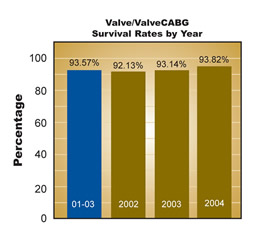The Strong Heart and Vascular Center is committed to providing physicians with data to help make informed decisions for patients. Below is the outcome data for our cardiac surgical services for the last three to four years. Excellence is the product of hard work, as our outcomes reveal. The Strong Heart and Vascular Center is dedicated to providing the highest quality cardiac care and outstanding patient outcomes.
 |  |
 |  |
Heart Surgery Volumes
| Procedures | Volumes | |||
| 2002 | 2003 | 2004 | 2005 | |
| CABG | 352 | 393 | 401 | 375 |
| CABG/Valve | 82 | 74 | 103 | 75 |
| Valve Surgery | 134 | 130 | 156 | 129 |
| Other | 123 | 123 | 114 | 142 |
| Total Volume | 691 | 720 | 774 | 721 |
Cardiac Surgery Survival Rates
| Surgical Procedures | 2002 | 2003 | 2004 | 2005 | ||||
| Survival Number | Survival Rate | Survival Number | Survival Rate | Survival Number | Survival Rate | Survival Number | Survival Rate | |
| CABG | 344 | 97.73% | 386 | 98.22% | 396 | 98.8% | 372 | 99.2% |
| CABG/Valve | 73 | 89% | 65 | 87.8% | 94 | 91.26% | 73 | 97.33% |
| Valve | 126 | 94% | 125 | 96.2% | 149 | 95.5% | 128 | 99.2% |
| Other | 107 | 87% | 106 | 86.2% | 95 | 83.3% | 114 | 80.3% |
Emergent Angioplasty Treatment
This data reflects emergent angioplasty to patients who present to our Emergency Department or who are transferred to our Emergency Department from other local hospitals. This life-saving procedure has proven to be the best option for decreasing further damage to the heart. One of the primary determinants of outcome for these patients is the time it takes for reperfusion, to open the artery, referred to as “door to balloon time.” We have been providing this treatment since 1998 with impressive results.

Myocardial Infarction
Since 1998, 24-hour/day emergent Percutaneous Coronary Intervention (PCI) for all STEMI patients has been available. Overall patient mortality and myocardial salvage correlate directly with rapidity of revascularization of the infract-related artery by PCI. Patient revascularization rates are markedly better than like hospitals (Source: NRMI database).

Pediatric Cardiac Surgery – Volumes and Survival Rate 2002
| Total Pediatric Cases | Survival Rate |
| 190 | 97.9% |
Program In Heart Failure and Transplantation
The Strong Heart Failure and Transplantation Program boasts some of the best outcomes in the nation and is a leader in Western New York in the implantation of Ventricular Assist Devices (VADs). Seventy-two (72) transplants have been performed since the program’s inception in February 2001.
One-Year Survival Rates
- Strong Memorial Hospital’s expected one-year survival rate for patients transplanted between 1/1/02 and 6/30/04 was 86.3%, while our actual survival rate was 87.5%. (Source: Scientific Registry of Transplant Recipients).
- The national average for one-year survival for patients transplanted between 1/1/02 and 6/30/04 was 87.46% (Source: Scientific Registry of Transplant Recipients).

Three-Year Survival Rates
- Strong Memorial Hospital’s expected three-year survival rate for patients transplanted between 1/1/00 and 6/30/02 was 75.48%, while our actual survival rate was 88.24%. (Source: Scientific Registry of Transplant Recipients).
- The national average for three-year survival for patients transplanted between 1/1/00 and 6/30/02 was 79.32% (Source: Scientific Registry of Transplant Recipients).


